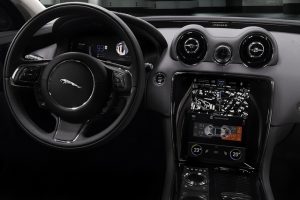
BlackBerry QNX seeks to drive future automotive market
By Grant Courville, senior director, product management - BlackBerry QNX
Electronics Engineering Software Regulations & Standards Wireless Engineering IoT Supply Chain automotive software embedded software embedded systemsBlackBerry’s embedded technologies are to design and develop secure, mission-critical solutions - ultimately accelerating product time to market.
EP&T Magazine conducted a Question & Answer session with Grant Courville, senior director, product management – BlackBerry QNX, to discuss the Kanata-based tech firm’s future objectives in the automotive software space. Courville is responsible for managing the company’s global product strategy for the automotive and general embedded markets.
———————————————
Q. Describe the rise in importance of BlackBerry QNX software for use in connected embedded systems in electronic designs today.
Safety, security, reliability and increased system complexity are key areas driving the need for BlackBerry QNX software. For example, these attributes of safety, security, reliability and the ability to handle complex use cases are needed in advanced driver assistance systems (ADAS) and autonomous vehicles. The OS is the foundational element upon which much of the remaining software is built.
With the push toward connected and autonomous vehicles, the electronic architecture of cars is evolving – from a multitude of lower performance processors each executing a dedicated function, to a small number of high performance domain controllers, powered by 64-bit processors and powerful graphical processing units. To develop these new systems, automotive OEMs and Tier 1 suppliers need a safe and secure 64-bit operating system (OS) that can run highly complex software, including neural networks and artificial intelligence algorithms.
In January, BlackBerry QNX unveiled our most advanced and secure OS for the automotive industry. QNX Software Development Platform 7.0 (QNX SDP 7.0) is a 64-bit OS that builds on the proven reliability of QNX technology and adds built-in security features.
QNX SDP 7.0 provides high performance and enhanced kernel-level security through an array of features, including microkernel architecture, file encryption, adaptive time partitioning, a high availability framework, anomaly detection, and multi-level policy-based access control. Featuring the next-generation QNX Neutrino Realtime OS and QNX Momentics Tool Suite, this reliable OS helps guard against system malfunctions, malware, and cyberattacks by implementing a multi-level, policy-driven security model that incorporates best-in-class security technology from BlackBerry.
QNX SDP 7.0 is suited not only for cars, but for almost any safety- or mission-critical application that requires 64-bit capability and advanced security. These applications for example include surgical robots, industrial controllers and high-speed trains.
The OS offers a safety pedigree proven by certification to ISO 26262 ASIL D (the highest level achievable) for automobiles and to IEC 61508 SIL 3 for industrial automation systems, and by compliance with IEC 62304 for life-critical Class III medical devices.
Q. Describe BlackBerry’s mission and/or intent with the launch of the QNX Platform for ADAS.
As safety and ADAS systems evolve from discrete single function systems, such as blind spot monitoring and lane departure warning, to integrated active safety systems and automated driving technologies, a new set of software challenges has emerged. The need for high performance computing along with the need for functional safety, changes the requirements of the hardware and software in these next-generation systems. The QNX Platform for ADAS has been designed to address these requirements by providing a flexible, safe and stable software environment that leverages the performance advances in silicon while maintaining ISO 26262 functional safety certification.
Based on our proven and trusted automotive experience and 30-year history in safety-critical systems, the platform provides the software foundation to help automotive companies reduce the time and effort of building a full range of ADAS systems and automated driving applications such as:
– Informational ADAS systems that provide a multi-camera, 360° surround view of the vehicle.
– Sensor fusion systems that combine data from multiple sources such as cameras and radar.
– Advanced high-performance systems that make control decisions in fully autonomous vehicles.
The QNX Platform for ADAS provides a framework and allows automakers to build the next-generation of ADAS systems by adding their differentiation with additional software elements.
Q. Why was Ottawa chosen as the city to open the BlackBerry QNX Autonomous Vehicle Innovation Centre (AVIC)? How many and what type of jobs are expected to be created?
The BlackBerry QNX Ottawa office is at the heart of BlackBerry’s automotive innovation, making it an easy pick for the AVIC headquarters. Ottawa’s Kanata suburb is also Canada’s largest technology park and home to more than 500 technology companies. The area boasts world-class post-secondary academic institutions, making them prime sources for new talent.
With the launch of the new centre in Ottawa, it is our goal to make Canada a global leader in autonomous vehicle innovation and development.
We cannot share specific hiring numbers, but I can tell you that we’re hiring and will continue to hire as we grow our business by focusing on innovation and providing world-class service and technology to our customers.
Q. Describe the pilot project of using BlackBerry QNX for testing autonomous vehicles on Ontario roads.
BlackBerry QNX was approved by the Ministry of Transportation of Ontario on November 28, 2016, to test autonomous vehicles on Ontario roads as part of the provincial government’s autonomous vehicle pilot program. The first public demonstration of the AVIC innovation was our autonomous concept car that we showcased at the Consumer Electronics Show (CES) in January 2017 where we demonstrated SAE Level 4 scenarios built on BlackBerry QNX software and Renesas hardware.
We are actively working with industry, academic and government partners to progress this technology and you will hear more about this in the near future.
Q. There is tremendous competition among many tech giants to try and dominate the market for embedded intelligence in connected and autonomous vehicles of the future. What are BlackBerry’s initial and long-term goals with BlackBerry QNX?
When automakers and Tier 1 suppliers think about BlackBerry and BlackBerry QNX, the following comes to mind – safety, security, trust and innovation. Our number one goal is to be the safe and secure automotive software platform provider that they trust for their automotive systems – including connected and autonomous vehicles. BlackBerry QNX is a proven and trusted provider of safe, secure and ultra-reliable software for the automotive market and has been doing so for the last 20 years. Our existing customers and the new entrants to the automotive market are working very closely with us to realize the cars of the future.
Coupled with BlackBerry’s security technologies we provide a safe, secure and trusted end-to-end software platform for connected and autonomous vehicles.
Q. Describe the breath of software platforms created by BlackBerry QNX, as supplied to the auto industry over the past 20-years.
BlackBerry QNX offers a complete vehicle software platform powered by a comprehensive portfolio of ADAS, infotainment, telematics, cluster, gateway, and acoustics solutions. Our solutions are deployed in more than 60 million vehicles worldwide. More than 40 automotive OEMs use BlackBerry QNX software, including the QNX Neutrino Realtime OS, the QNX CAR Platform for Infotainment, the QNX OS for Safety, and QNX acoustics middleware, for their head units, digital instrument clusters, ADAS features, hands-free systems, and connectivity modules.
Additional milestones include:
* The number-1 automotive software for infotainment.
* The number-1 OS in telematics.
* 50 million hands-free software units shipped.
* 100 percent success rate of meeting automotive OEM start of production deadlines.
The trend toward electronic control unit (ECU) consolidation via domain controllers in the car provides even more opportunity for BlackBerry software in each vehicle.
Q. Describe the importance of having advanced security technologies as part of the future connected car infrastructure.
Today’s high-end cars contain more than 100 million lines of software code – that dwarfs the amount of code in the space shuttle, Boeing 787 Dreamliner, and Microsoft Office combined. When you think about this in the context of connected and autonomous vehicles, it is critical that this software is kept secure to ensure it functions properly and cannot be hacked.
In a standard OS, if an attacker gains root access, they can do anything. That’s why most cyberattacks ultimately boil down to injecting software that can run as a root into a system in the car – which gives them full access to the ECU and potentially any other system in the car (in essence, having the key to every room and safe). That is not the case with QNX OS. With the QNX Neutrino Realtime OS, systems can be constructed in which no single process is running as root – you create a truly rootless system.
Additionally, as referenced above, the QNX SDP 7.0 is much more than an OS –this 64-bit OS features a policy-driven security model that incorporates BlackBerry’s best-in-class security technology. It is the most advanced and secure embedded platform on the market, designed from the ground-up for security and availability.
BlackBerry also provides secure key distribution during the manufacturing process and the life of the vehicle through the Certicom Asset Management System (AMS) and Public Key Infrastructure (PKI) platforms. Automotive customers can use Certicom technology to provision a component with a secure key at the time of manufacture, then manage electronic subsystem keys throughout the vehicle’s lifespan to secure module communications and to ensure that air bags, brake control modules, and other safety-critical components are not counterfeited, but manufactured by trusted OEM suppliers. A BlackBerry subsidiary, Certicom is an applied cryptography and key management specialist enabling end-to-end security for smart, connected devices.
Completing the picture, BlackBerry’s secure OTA managed services make it easy to update software and security assets over the air. When it comes to automotive security, BlackBerry brings it all together to make it BlackBerry Secure.
Q. BlackBerry QNX provides a software platform upon which OEMs can build a safe, secure, reliable, and high-performance applications for many markets. Which markets do you anticipate greatest usage or application in the coming year(s) telecommunications, automotive, medical instrumentation, automation, security, IoT, Robotics, etc.?
The automotive market will continue to grow with both safety-critical (e.g. ADAS, digital instrument clusters) and non-safety systems (e.g. infotainment) systems.
Additionally, in the medical and industrial markets, BlackBerry QNX will continue to grow its footprint by powering mission-critical systems including surgical systems, energy control and monitoring, rail transportation, and autonomous robots and machinery.
The needs of many of these complex and connected embedded systems will necessitate even more features and functionality provided by the various BlackBerry solutions.
Q. Will BlackBerry QNX be involved in Ford’s autonomous vehicle development? If so, to what extent?
We cannot comment on customer projects. However, as Ford mentioned last year, growing their expertise and experience in the use of BlackBerry QNX embedded software platforms will help ensure they deliver the high-quality, highly secure experience that their customers expect.
Q. What makes BlackBerry QNX such a good fit in the automotive space (i.e. leveraging the safety, security, and reliability of BlackBerry QNX)?
Simple – 20 years of proven reliability, innovation and trust in automotive now complemented by industry leading security and software update capabilities from BlackBerry.
In today’s market, automakers are challenged by regulatory and consumer demands:
* To improve fuel efficiency with techniques such as cylinder deactivation creates noise, vibration and harshness (NVH), which have to be suppressed.
* Adding advanced connectivity, which increases the need to protect the car from hackers and manage privacy of user data.
* Manage the growing computational needs in cars to offer advanced features like ADAS, yet contain cost and weight of cars from increasing.
* Develop autonomous cars and ensure they are safe.
* Adopt common electronic platforms yet differentiate to enhance their brands.
Only BlackBerry QNX can offer software for the whole car – cluster, in-vehicle infotainment, connectivity, gateways, hypervisor, ADAS and autonomous driving systems – with advanced security built in from the car to the cloud. BlackBerry QNX provides flexible, scalable solutions that enable the industries’ challenges to be met and advanced capabilities to be brought to market quickly, on time and in budget.


